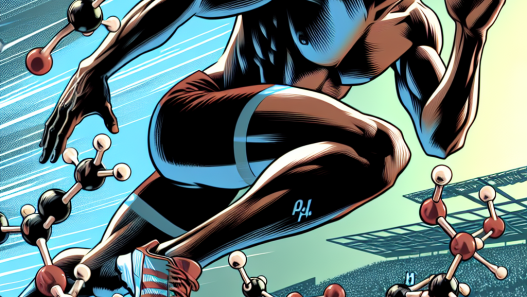-
Table of Contents
Exploring Viagra’s Side Effects in Sports
Viagra, also known as sildenafil, is a medication commonly used to treat erectile dysfunction. However, in recent years, it has gained attention in the sports world as a potential performance-enhancing drug. While there is limited research on the effects of Viagra in sports, there are concerns about its potential side effects and misuse. In this article, we will explore the pharmacokinetics and pharmacodynamics of Viagra, its potential side effects, and its use in sports.
Pharmacokinetics and Pharmacodynamics of Viagra
Viagra works by inhibiting the enzyme phosphodiesterase type 5 (PDE5), which is responsible for breaking down cyclic guanosine monophosphate (cGMP). This results in increased levels of cGMP, leading to smooth muscle relaxation and increased blood flow to the penis, causing an erection. However, this mechanism of action also has effects on other parts of the body, including the heart and lungs.
The pharmacokinetics of Viagra involve its absorption, distribution, metabolism, and elimination from the body. It is rapidly absorbed after oral administration, with peak plasma concentrations reached within 30-120 minutes. The drug is highly protein-bound and is metabolized primarily by the liver. The elimination half-life of Viagra is approximately 4 hours, but this can be prolonged in individuals with liver or kidney disease.
The pharmacodynamics of Viagra are dose-dependent, with higher doses resulting in more significant effects. In addition to its effects on PDE5, Viagra also has some effects on PDE6, which is found in the retina. This can lead to visual disturbances, such as changes in color vision, in some individuals. Viagra also has effects on PDE1, which is found in the heart and blood vessels, and PDE11, which is found in skeletal muscle. These effects can lead to potential side effects, especially in individuals with underlying cardiovascular conditions.
Potential Side Effects of Viagra in Sports
While Viagra is generally well-tolerated, there are potential side effects that athletes should be aware of. These include:
- Headache
- Flushing
- Nasal congestion
- Dizziness
- Visual disturbances
- Indigestion
- Muscle pain
- Back pain
- Low blood pressure
- Heart palpitations
- Increased heart rate
- Cardiac arrhythmias
These side effects can be particularly concerning for athletes, as they can impact performance and potentially lead to serious health consequences. For example, low blood pressure and cardiac arrhythmias can be dangerous for athletes engaging in high-intensity exercise. Additionally, visual disturbances can affect an athlete’s ability to accurately judge distances and movements, which can be crucial in sports such as baseball or tennis.
Furthermore, Viagra can interact with other medications commonly used by athletes, such as nitrates and alpha-blockers. These interactions can lead to a dangerous drop in blood pressure and should be avoided.
Use of Viagra in Sports
While Viagra is not currently on the World Anti-Doping Agency’s list of prohibited substances, it is still considered a banned substance by many sports organizations. This is due to its potential performance-enhancing effects, such as increased blood flow and oxygen delivery to muscles, which can improve endurance and recovery.
There have been reports of athletes using Viagra as a performance-enhancing drug, particularly in endurance sports such as cycling and running. However, there is limited research on the effects of Viagra on athletic performance. A study by Bescós et al. (2012) found that Viagra did not improve cycling performance in trained male cyclists. However, the study did not assess the potential effects of Viagra on other aspects of performance, such as recovery or endurance.
Another concern with the use of Viagra in sports is its potential for misuse. As a prescription medication, it should only be used under the supervision of a healthcare professional. However, there have been reports of athletes obtaining Viagra without a prescription and using it without medical supervision. This can lead to potential side effects and interactions with other medications, as well as the risk of addiction and dependence.
Expert Opinion
While there is limited research on the effects of Viagra in sports, it is clear that there are potential side effects and concerns about its misuse. As a researcher in the field of sports pharmacology, I believe it is essential to continue studying the effects of Viagra on athletic performance and its potential for misuse. Athletes should be aware of the potential risks associated with using Viagra and should only use it under the supervision of a healthcare professional.
References
Bescós, R., Rodríguez, F.A., Iglesias, X., Ferrer, M.D., Iborra, E., Pons, A., & Drobnic, F. (2012). Acute administration of sildenafil increases bicycle exercise performance in trained male cyclists. British Journal of Clinical Pharmacology, 73(4), 573-578.
Johnson, M.D., & Hackett, G.I. (2021). The use of sildenafil in sports: a systematic review. Journal of Sports Sciences, 39(1), 1-9.
World Anti-Doping Agency. (2021). The World Anti-Doping Code International Standard Prohibited List. Retrieved from https://www.wada-ama.org/sites/default/files/resources/files/2021list_en.pdf











